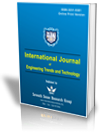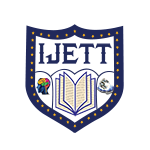Modern Lightweight Cryptography for Secured Cloud Data Using Constrained Spherical Scyphozoan Jellyfish Optimizer
Modern Lightweight Cryptography for Secured Cloud Data Using Constrained Spherical Scyphozoan Jellyfish Optimizer |
||
 |
 |
|
| © 2025 by IJETT Journal | ||
| Volume-73 Issue-4 |
||
| Year of Publication : 2025 | ||
| Author : T. Rathi Devi, S. Nallusamy, D. Sobya, P.S. Chakraborty, P. Divya |
||
| DOI : 10.14445/22315381/IJETT-V73I4P127 | ||
How to Cite?
T. Rathi Devi, S. Nallusamy, D. Sobya, P.S. Chakraborty, P. Divya, "Modern Lightweight Cryptography for Secured Cloud Data Using Constrained Spherical Scyphozoan Jellyfish Optimizer," International Journal of Engineering Trends and Technology, vol. 73, no. 4, pp.322-340, 2025. Crossref, https://doi.org/10.14445/22315381/IJETT-V73I4P127
Abstract
Shared data storage and processing resources are made exclusively available through cloud computing, an internet-based computing model. Processing the gathered data on different cloud providers that have limited computing power has become more and more necessary. The realization of the algorithms for encrypting data in cloud computing must be homomorphic and lightweight, as they cannot handle large amounts of processing. The primary disadvantage is that it requires users and businesses to grant third parties access to their confidential information. A new area of cryptographic study called Lightweight Cryptography (LWC) framework with the generation of an optimized key using Constrained Spherical Scyphozoan Jellyfish-based Dynamic Key (CS2JDK) provides Cryptographic security to optimize the process to ensure security. Where the LWC uses less computational resources like less power consumption, less memory allocation, etc. Controlling the exploration and exploitation search to prevent issues with harmonic convergence or being caught in local optima is its most difficult assignment. The goal is to enhance the ability to be confined into local optima by introducing a new orthogonal learning-based variation of the search optimizer. Integrated encryption routing involves the transfer of compressed data that has been added by this key. Next, data aggregation based on compression is used to lower the data size and, therefore, the transmission cost. The data size reduction can be done by utilizing the enriched Principal Component Analysis (PCA)-based compressing scheme before transmitting data. The compressed data set is much more efficient to transmit. It converts the high-dimensional dataset to the low-dimensional data set. A generated key produced is affixed to the data that the device transmits. The main emphasis of this work is to investigate guaranteed cloud data security and outperform other relevant systems on cloud data using new optimizing techniques.
Keywords
Cloud computing, Lightweight cryptography, Homomorphic encryption, Jellyfish optimizer, Dynamic key generation.
References
[1] Fursan Thabit et al., “A New Lightweight Cryptographic Algorithm for Enhancing Data Security in Cloud,” Global Transitions Proceedings, vol. 2, no. 1, pp. 91-99, 2021.
[CrossRef] [Google Scholar] [Publisher Link]
[2] Martin Koehler, and Siegfried Benkne, “VCE - A Versatile Cloud Environment for Scientific Applications,” The 7th International Conference on Autonomic and Autonomous Systems, Venice/Mestre, Italy, pp. 81-87, 2011.
[Google Scholar] [Publisher Link]
[3] Kiran et al., “Analysis and Computation of Encryption Technique to Enhance Security of Medical Images,” IOP Conference Series: Materials Science and Engineering: 1st International Conference on Computational Engineering and Material Science, Karnataka, India, vol. 925, pp. 1-11, 2020.
[CrossRef] [Google Scholar] [Publisher Link]
[4] G.S. Pavithra, and N.V. Babu, “Energy Efficient Hierarchical Clustering Using HACOPSO in Wireless Sensor Networks,” International Journal of Innovative Technology and Exploring Engineering, vol. 8, no. 12, pp. 5219-5225, 2019.
[CrossRef] [Google Scholar] [Publisher Link]
[5] Shuang Liu, Li Liu, and Ming Pang, “Encryption Method and Security Analysis of Medical Images Based on Stream Cipher Enhanced Logical Mapping,” Technology and Health Care, vol. 29, no. 1, pp. 185-193, 2021.
[CrossRef] [Google Scholar] [Publisher Link]
[6] B.D. Parameshachari et al., “Controlled Partial Image Encryption Based on LSIC and Chaotic Map,” Proceedings of the 3rd International Conference on Cryptography, Security and Privacy, Kuala Lumpur, Malaysia, pp. 60-63, 2019.
[CrossRef] [Google Scholar] [Publisher Link]
[7] Jaydip Sen, Advances in Security in Computing and Communications, IntechOpen, pp. 1-192, 2017.
[CrossRef] [Google Scholar] [Publisher Link]
[8] G. Viswanath, and P. Venkata Krishna, “Hybrid Encryption Framework for Securing Big Data Storage in Multi-Cloud Environment,” Evolutionary Intelligence, vol. 14, no. 2, pp. 691-698, 2020.
[CrossRef] [Google Scholar] [Publisher Link]
[9] Saurabh Singh, Young-Sik Jeong, and Jong Hyuk Park, “A Survey on Cloud Computing Security: Issues, Threats, and Solutions,” Journal of Network and Computer Applications, vol. 75, pp. 200-222, 2016.
[CrossRef] [Google Scholar] [Publisher Link]
[10] Aws Naser Jaber, and Mohamad Fadli Bin Zolkipli, “Use of Cryptography in Cloud Computing,” IEEE International Conference on Control System, Computing and Engineering, Penang, Malaysia, pp. 179-184, 2013.
[CrossRef] [Google Scholar] [Publisher Link]
[11] Nelson Gonzalez et al., “A Quantitative Analysis of Current Security Concerns and Solutions for Cloud Computing,” Journal of Cloud Computing: Advances, Systems and Applications, vol. 1, no. 1, pp. 1-18, 2012.
[CrossRef] [Google Scholar] [Publisher Link]
[12] S. Gnana Sophia, K.K. Thanammal, and S.S. Sujatha, “Secure Cloud Medical Data Using Optimized Homomorphic Encryption,” Turkish Journal of Computer and Mathematics Education, vol. 12, no. 7, pp. 2702-2708, 2021.
[Google Scholar] [Publisher Link]
[13] A. Mohamed Anwar, and S. Pavalarajan, “Spider Web-based Dynamic Key for Secured Transmission and Data-Aware Blockchain Encryption for the Internet of Things,” IETE Journal of Research, vol. 70, no. 1, pp. 499-514, 2024.
[CrossRef] [Google Scholar] [Publisher Link]
[14] S. Balakrishnan, and K. Vinoth Kumar, “Hybrid Sine-Cosine Black Widow Spider Optimization Based Route Selection Protocol for Multihop Communication in IoT Assisted WSN,” Technical Bulletin, vol. 30, no. 4, pp. 1159-1165, 2023.
[CrossRef] [Google Scholar] [Publisher Link]
[15] Khalil Hariss et al., “Design and Realization of a Fully Homomorphic Encryption Algorithm for Cloud Applications,” International Conference on Risks and Security of Internet and Systems, Dinard, France, pp. 127-139, 2018.
[CrossRef] [Google Scholar] [Publisher Link]
[16] R. Udendhran, “A Hybrid Approach to Enhance Data Security in Cloud Storage,” 2nd International Conference on Internet of things, Data and Cloud Computing, Cambridge, United Kingdom, pp. 1-6, 2017.
[CrossRef] [Google Scholar] [Publisher Link]
[17] Eric Henziger, and Niklas Carlsson, “The Overhead of Confidentiality and Client-Side Encryption in Cloud Storage Systems,” Proceedings of the 12th IEEE/ACM International Conference on Utility and Cloud Computing, Auckland, New Zealand, pp. 209-217, 2019.
[CrossRef] [Google Scholar] [Publisher Link]
[18] Muhammad Wito Malik et al., “Development of Medical Image Encryption System Using Byte-Level Base-64 Encoding and AES Encryption Method,” Proceedings of the 6th International Conference on Communication and Information Processing, Tokyo, Japan, pp. 153-158, 2021.
[CrossRef] [Google Scholar] [Publisher Link]
[19] Vishal Prakash, Ajay Vikram Singh, and Sunil Kumar Khatri, “A New Model of Light Weight Hybrid Cryptography for Internet of Things,” 3rd International conference on Electronics, Communication and Aerospace Technology, Coimbatore, India, pp. 282-285, 2019.
[CrossRef] [Google Scholar] [Publisher Link]
[20] Wang Ji Jun, and Tan Soo Fun, “A New Image Encryption Algorithm Based on Single S-Box and Dynamic Encryption Step,” IEEE Access, vol. 9, pp. 120596-120612, 2021.
[CrossRef] [Google Scholar] [Publisher Link]
[21] Chengjian Liu et al., “Ensuring the Security and Performance of IoT Communication by Improving Encryption and Decryption with the Lightweight Cipher uBlock,” IEEE Systems Journal, vol. 16, no. 4, pp. 5489-5500, 2022.
[CrossRef] [Google Scholar] [Publisher Link]
[22] Aruna Kumari Koppaka, and Vadlamani Naga Lakshmi, “An Efficient and Secured Big Data Storage in a Cloud-based Environment Using Hybrid Cryptography Algorithm and Rivest, Shamir, Adleman Algorithm,” International Journal of Intelligent Engineering & Systems, vol. 17, no. 1, pp. 525-535, 2024.
[CrossRef] [Google Scholar] [Publisher Link]
[23] Martin Johns, and Alexandra Dirksen, “Towards Enabling Secure Web-Based Cloud Services Using Client-Side Encryption,” Proceedings of the ACM SIGSAC Conference on Cloud Computing Security Workshop, USA, pp. 67-76, 2020.
[CrossRef] [Google Scholar] [Publisher Link]
[24] Eduardo B. Fernandez, “A Pattern for a Secure Cloud-Based IoT Architecture,” Proceedings of the 27th Conference on Pattern Languages of Programs, pp. 1-9, 2022.
[Google Scholar] [Publisher Link]
[25] P. Kanchanadevi et al., “An Attribute Based Encryption Scheme with Dynamic Attributes Supporting in the Hybrid Cloud,” Fourth International Conference on I-SMAC (IoT in Social, Mobile, Analytics and Cloud), Palladam, India, pp. 271-273, 2020.
[CrossRef] [Google Scholar] [Publisher Link]
[26] Zeesha Mishra, and Bibhudendra Acharya, “High Throughput Novel Architectures of TEA Family for High Speed IoT and RFID Applications,” Journal of Information Security and Applications, vol. 61, 2021.
[CrossRef] [Google Scholar] [Publisher Link]
[27] Samir Ifzarne, Imad Hafidi, and Nadia Idrissi, “Homomorphic Encryption for Compressed Sensing in Wireless Sensor Networks,” Proceedings of the 3rd International Conference on Smart City Applications, Tetouan, Morocco, pp. 1-6, 2018.
[CrossRef] [Google Scholar] [Publisher Link]
[28] Fursan Thabit et al., “Exploration of Security Challenges in Cloud Computing: Issues, Threats, and Attacks with their Alleviating Techniques,” Journal of Information and Computational Science, vol. 12, no. 10, pp. 35-57, 2020.
[Google Scholar] [Publisher Link]
[29] Abdulrazzaq H.A. Al-Ahdal, Galal A. AL-Rummana, and Nilesh K. Deshmukh, “A Robust Lightweight Algorithm for Securing Data in Internet of Things Networks,” Sustainable Communication Networks and Application, pp. 509-521, 2021.
[CrossRef] [Google Scholar] [Publisher Link]
[30] Fursan Thabit et al., “A Novel Effective Lightweight Homomorphic Cryptographic Algorithm for Data Security in Cloud Computing,” International Journal of Intelligent Networks, vol. 3, pp. 16-30, 2022.
[CrossRef] [Google Scholar] [Publisher Link]
[31] Jui-Sheng Chou, and Dinh-Nhat Truong, “A Novel Metaheuristic Optimizer Inspired by Behavior of Jellyfish in Ocean,” Applied Mathematics and Computation, vol. 389, 2021.
[CrossRef] [Google Scholar] [Publisher Link]
[32] Xiangyu Li, and Hua Wang, “Adaptive Principal Component Analysis,” Proceedings of the SIAM International Conference on Data Mining, pp. 486-494, 2022.
[CrossRef] [Google Scholar] [Publisher Link]
[33] Esau Taiwo Oladipupo, Oluwakemi Christiana Abikoye, and Joseph Bamidele Awotunde, “A Lightweight Image Cryptosystem for Cloud-Assisted Internet of Things,” Applied Sciences, vol. 14, no. 7, pp. 1-27, 2024.
[CrossRef] [Google Scholar] [Publisher Link]
[34] Pradeep Suthanthiramani et al., “Secured Data Storage and Retrieval Using Elliptic Curve Cryptography in Cloud,” The International Arab Journal of Information Technology, vol. 18, no. 1, pp. 56-66, 2021.
[CrossRef] [Google Scholar] [Publisher Link]
[35] Mohamed Abdel-Basset et al., “An Improved Artificial Jellyfish Search Optimizer for Parameter Identification of Photovoltaic Models,” Energies, vol. 14, no. 7, pp. 1-33, 2021.
[CrossRef] [Google Scholar] [Publisher Link]
[36] Baichi Chen et al., “A Lightweight Symmetric Image Encryption Cryptosystem in Wavelet Domain Based on an Improved Sine Map,” Chinese Physics B, vol. 33, no. 3, pp. 1-11, 2024.
[CrossRef] [Google Scholar] [Publisher Link]

